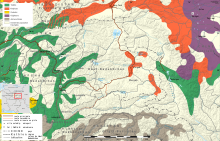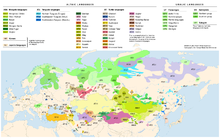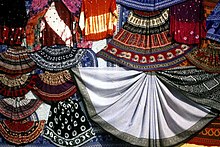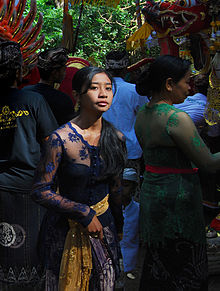Ethnic groups in Asia
This article has multiple issues. Please help improve it or discuss these issues on the talk page. (Learn how and when to remove these template messages)
|
| Total population | ||
|---|---|---|
| 4,533,765,005 59.4% of the total world population (World population of 7.5 billion) Southeast Asians (Eastern Asians)[2] |
| |
| 1,384,688,986[3] | ||
| 1,296,834,042[4] | ||
| 262,787,403[5] | ||
| 238,181,034[6] | ||
| 164,098,818[7] | ||
| 126,168,156[8] | ||
| 100,006,900[9] | ||
| 97,040,334[10] | ||
| 68,615,858[11] | ||
| 57,069,099[12] | ||
| 51,418,097[13] | ||
| 30,424,878[14] | ||
| 25,831,360[15] | ||
| 23,545,963[16] | ||
| 23,044,123[17] | ||
| 18,744,548[18] | ||
| 17,288,489[19] | ||
| 7,213,338[20] | ||
| 5,996,000[21] | ||
| West Asia (Western Asians) |
| |
others | ||
The ancestral population of modern
Migrations of distinct
In terms of

Some groups are primarily
History
This section needs expansion. You can help by adding to it. (January 2022) |
Central Asia

The main religions of Central Asia are
The
The literature of Central Asia is linked with
East Asia

The major East Asian language families are the
Throughout the ages, the greatest
The script of the Han Chinese characters has long been a unifying feature in East Asia as the vehicle for exporting Chinese culture to its East Asian neighbors.[77] Chinese characters became the unifying language of bureaucratic politics and religious expression in East Asia.[77] The Chinese script was passed on first to Korea, Vietnam in the 1st century, then to Japan, where it forms a major component of the Japanese writing system. In Korea, Sejong the Great invented the hangul alphabet in 1443, which later became the main orthographic system for the Korean language in the 19th century.[78] In Japan, much of the Japanese language is written in hiragana and katakana in addition to Chinese characters.[76]
North Asia

The geographic region of
South Asia


Regions of Nepal and parts of the Indian states and territories of Arunachal Pradesh, Himachal Pradesh, Jammu and Kashmir, Ladakh, Sikkim, and Uttarakhand have cultural similarity to Tibet, Tibetan Buddhism being the dominant religion there. Finally the Northeast Indian states of Meghalaya, Mizoram, Manipur, Nagaland, and tribal groups of Assam and Tripura have cultural affinities with Southeast Asia.
Bhutanese are often referred to in their literature as "Bhote" (people of Bhutia/Bhotia or Tibet). They follow Tibetan Buddhism to and it is a dominant political and cultural element in modern
Southeast Asia
Demographically, Southeast Asia has had little Western immigration, although Western influence still exists due to the lasting legacy of
A common feature found around the region is
West Asia


West Asia is sometimes referred to as "Southwest Asia". West Asia consists of Armenia, Azerbaijan, Bahrain, Cyprus, Georgia, Iran, Iraq, Israel, Jordan, Kuwait, Lebanon, Oman, Palestine, Qatar, Saudi Arabia, Syria, United Arab Emirates, Yemen, most of Turkey, and part of Egypt.
Culturally, the region's dominant ethnic groups are
Other minorities and migrant groups
This article possibly contains original research. (February 2020) |
Europeans, Russian nationals, North Americans, and South Americans


At least 21 million of European, Russian, North American and South American nationalities and heritage live in Asia, representing 0.45% of the total population of Asia. The following is a list of people with such ancestry and nationality, including people of mixed heritage of part Asian and part European/North American/South American, living in Asian countries, also showing the main country of origin.
![]() Philippines 5 million (Spain, 4.7% of total population)[citation needed]
Philippines 5 million (Spain, 4.7% of total population)[citation needed]
![]() Kazakhstan 3.5 million (Russia, 19% of total population)[80]
Kazakhstan 3.5 million (Russia, 19% of total population)[80]
![]() India 1.7 million (United Kingdom, 0.12% of total population)[81][82]
India 1.7 million (United Kingdom, 0.12% of total population)[81][82]
![]() Kyrgyzstan 837,000 (Russia, 13.5% of total population)[83]
Kyrgyzstan 837,000 (Russia, 13.5% of total population)[83]
![]() Uzbekistan 750,000 (Russia, 2.3% of total population)[84]
Uzbekistan 750,000 (Russia, 2.3% of total population)[84]
![]() United Arab Emirates 461,000 (United Kingdom, 4.9% of total population)[85][86]
United Arab Emirates 461,000 (United Kingdom, 4.9% of total population)[85][86]
![]() Turkmenistan 297,913 (Russia, 5.1% of total population)[87]
Turkmenistan 297,913 (Russia, 5.1% of total population)[87]
![]() Thailand 250,000 (United Kingdom, 0.36% of total population)[88]
Thailand 250,000 (United Kingdom, 0.36% of total population)[88]
![]() South Korea 245,000 (United States, 0.48% of total population)[89]
South Korea 245,000 (United States, 0.48% of total population)[89]
![]() Hong Kong 218,209 (United States, 3.1% of total population)[90][91][92]
Hong Kong 218,209 (United States, 3.1% of total population)[90][91][92]
![]() Indonesia 189,000 (Netherlands, 0.071% of total population)[93][94]
Indonesia 189,000 (Netherlands, 0.071% of total population)[93][94]
![]() Pakistan 149,253 (United Kingdom, 0.07% of total population)[95]
Pakistan 149,253 (United Kingdom, 0.07% of total population)[95]
![]() Syria 120,000 (Russia, 0.7% of total population)[96]
Syria 120,000 (Russia, 0.7% of total population)[96]
![]() Azerbaijan 119,300 (Russia, 1.2% of total population)[97]
Azerbaijan 119,300 (Russia, 1.2% of total population)[97]
![]() Qatar 115,000 (United States, 4.3% of total population)[98]
Qatar 115,000 (United States, 4.3% of total population)[98]
![]() Bangladesh 110,138 (United States, 0.06% of total population)[99]
Bangladesh 110,138 (United States, 0.06% of total population)[99]
![]() Cyprus 109,462 (United Kingdom, 9.1% of total population)[100]
Cyprus 109,462 (United Kingdom, 9.1% of total population)[100]
![]() Japan 106,000 (United States, 0.08% of total population)[101]
Japan 106,000 (United States, 0.08% of total population)[101]
![]() Saudi Arabia 100,000 (United States, 0.3% of total population)[102]
Saudi Arabia 100,000 (United States, 0.3% of total population)[102]
![]() Singapore 76,900 (United Kingdom, 1.3% of total population)[103][104]
Singapore 76,900 (United Kingdom, 1.3% of total population)[103][104]
![]() Tajikistan 68,200 (Russia, 1.1% of total population)[83]
Tajikistan 68,200 (Russia, 1.1% of total population)[83]
![]() Jordan 65,000 (Russia, 0.67% of total population)[105]
Jordan 65,000 (Russia, 0.67% of total population)[105]
![]() Iran 50,000 (Russia, 0.061% of total population)[106]
Iran 50,000 (Russia, 0.061% of total population)[106]
![]() Malaysia 37,000 (Portugal, 0.11% of total population)[107]
Malaysia 37,000 (Portugal, 0.11% of total population)[107]
![]() Georgia 26,453 (Russia, 0.7% of total population)[108]
Georgia 26,453 (Russia, 0.7% of total population)[108]
![]() Lebanon 25,000 (United States, 0.41% of total population)[108]
Lebanon 25,000 (United States, 0.41% of total population)[108]
![]() Taiwan 21,000 (United States, 0.09% of total population)[109]
Taiwan 21,000 (United States, 0.09% of total population)[109]
![]() Myanmar 19,200 (United Kingdom, 0.035% of total population)[110]
Myanmar 19,200 (United Kingdom, 0.035% of total population)[110]
![]() Oman 16,349 (United Kingdom, 0.39% of total population)[111]
Oman 16,349 (United Kingdom, 0.39% of total population)[111]
![]() Bahrain 15,000 (United Kingdom, 1% of total population)[112]
Bahrain 15,000 (United Kingdom, 1% of total population)[112]
![]() Afghanistan 13,000 (United States, 0.037% of total population)[113]
Afghanistan 13,000 (United States, 0.037% of total population)[113]
![]() Kuwait 13,000 (United States, 0.031% of total population)[114]
Kuwait 13,000 (United States, 0.031% of total population)[114]
![]() Macau 13,000 (Portugal, 2.3% of total population)[115]
Macau 13,000 (Portugal, 2.3% of total population)[115]
![]() Armenia 11,911 (Russia, 0.4% of total population)[116]
Armenia 11,911 (Russia, 0.4% of total population)[116]
![]() Sri Lanka 8,856 (Italy, 0.04% of total population)[117]
Sri Lanka 8,856 (Italy, 0.04% of total population)[117]
![]() Iraq 6,000 (United States, 0.015% of total population)[114]
Iraq 6,000 (United States, 0.015% of total population)[114]
![]() Mongolia 3,000 (Russia, 0.1% of total population)[118]
Mongolia 3,000 (Russia, 0.1% of total population)[118]
![]() Nepal 3,000 (United States, 0.01% of total population)[119]
Nepal 3,000 (United States, 0.01% of total population)[119]
![]() Vietnam 2,700 (United States, 0.002% of total population)[120]
Vietnam 2,700 (United States, 0.002% of total population)[120]
![]() North Korea 2,045 (United States, 0.008% of total population)[121]
North Korea 2,045 (United States, 0.008% of total population)[121]
![]() Maldives 1,117 (Germany, 0.25% of total population)[122]
Maldives 1,117 (Germany, 0.25% of total population)[122]
![]() Cambodia 1,000 (France, 0.006% of total population)[123][124]
Cambodia 1,000 (France, 0.006% of total population)[123][124]
![]() Yemen 1,000 (United States, 0.003% of total population)[125][126]
Yemen 1,000 (United States, 0.003% of total population)[125][126]
See also
- Asian people
- Australoid
- Black people
- Brown (racial classification)
- Caucasoid
- Culture of Asia
- Demographics of Asia
- Indigenous peoples of Asia
- Languages of Asia
- Mongoloid
- Negroid
- Proto-Australoid
- White people
References
- ^ "Population of Asia (2022) - Worldometer". Worldometers.info. Archived from the original on 21 July 2019. Retrieved 15 March 2022.
- ^ "Land Use – Ecosystem – Climate Interactions in Monsoon Asia". lcluc.umd.edu. NASA. Archived from the original on 10 January 2021. Retrieved 15 February 2020.
- ^ "The World Factbook". Cia.gov. Central Intelligence Agency. Retrieved 27 May 2019.
- ^ "The World Factbook". Cia.gov. Central Intelligence Agency. Retrieved 27 May 2019.
- ^ "The World Factbook". Cia.gov. Central Intelligence Agency. Retrieved 27 May 2019.
- ^ "The World Factbook". Cia.gov. Central Intelligence Agency. Retrieved 19 February 2022.
- ^ "The World Factbook". Cia.gov. Central Intelligence Agency. Retrieved 27 May 2019.
- ^ "The World Factbook". Cia.gov. Central Intelligence Agency. Retrieved 27 May 2019.
- ^ "The World Factbook". Cia.gov. Central Intelligence Agency. Retrieved 27 May 2019.
- ^ "The World Factbook". Cia.gov. Central Intelligence Agency. Retrieved 27 May 2019.
- ^ "The World Factbook". Cia.gov. Central Intelligence Agency. Retrieved 27 May 2019.
- ^ "The World Factbook". Cia.gov. Central Intelligence Agency. Retrieved 19 February 2022.
- ^ "The World Factbook". Cia.gov. Central Intelligence Agency. Retrieved 27 May 2019.
- ^ "The World Factbook". Cia.gov. Central Intelligence Agency. Retrieved 19 February 2022.
- ^ "The World Factbook". Cia.gov. Central Intelligence Agency. 17 February 2022. Retrieved 19 February 2022.
- ^ "The World Factbook". Cia.gov. Central Intelligence Agency. Retrieved 27 May 2019.
- ^ "The World Factbook". Cia.gov. Central Intelligence Agency. 14 February 2022. Retrieved 19 February 2022.
- ^ "The World Factbook". Cia.gov. Central Intelligence Agency. Retrieved 31 December 2019.
- ^ "The World Factbook". Cia.gov. Central Intelligence Agency. Retrieved 15 February 2020.
- ^ "The World Factbook". Cia.gov. Central Intelligence Agency. Retrieved 27 May 2019.
- ^ "The World Factbook". Cia.gov. Central Intelligence Agency. Retrieved 27 May 2019.
- ^ "The World Factbook". Cia.gov. Central Intelligence Agency. Retrieved 7 June 2021.
- ^ "The World Factbook". Cia.gov. Central Intelligence Agency. Archived from the original on 10 January 2021. Retrieved 31 December 2019.
- ^ "The World Factbook". Cia.gov. Central Intelligence Agency. Retrieved 25 August 2021.
- ^ "The World Factbook". Cia.gov. Central Intelligence Agency. Retrieved 31 December 2019.
- ^ "The World Factbook". Cia.gov. Central Intelligence Agency. Retrieved 31 December 2019.
- ^ "The World Factbook". Cia.gov. Central Intelligence Agency. Retrieved 31 December 2019.
- ^ "The World Factbook". Cia.gov. Central Intelligence Agency. Retrieved 31 December 2019.
- ^ "The World Factbook". Cia.gov. Central Intelligence Agency. Retrieved 31 December 2019.
- ^ "Middle East :: Lebanon — The World Factbook – Central Intelligence Agency". www.cia.gov. Retrieved 19 April 2020.
- ^ "Worldometer". Worldometer.com. Worldometer. Retrieved 17 May 2023.
- ^ "Worldometer". State of Palestine. Archived from the original on 8 June 2014.
- ^ "Ethnic groups Prehistoric centres and ancient migrations". Encyclopedia Britannica. Retrieved 23 September 2018.
- PMID 17568987. Retrieved 23 September 2018.)
{{cite journal}}: CS1 maint: multiple names: authors list (link - ISBN 9780858836389.
- ^ "New research forces U-turn in population migration theory". eurekalert. Retrieved 23 September 2018.
- ^ "Origins of Ethnolinguistic Identity in Southeast Asia" (PDF). Roger Blench. Retrieved 23 September 2018.
- ^ "From ethnocide to ethnodevelopment? Ethnic minorities and indigenous peoples in Southeast Asia" (PDF). JSTOR. Retrieved 23 September 2018.
- ISBN 9788124110669.
- ^ a b "Introducing East Asian Peoples" (PDF). International Mission Board. 10 September 2016.
- ^ "How Asians view each other". The Economist. 18 September 2015.
- ^ Khoo, Isabelle (30 May 2017). "The Difference Between East Asians And South Asians Is Pretty Simple". Huffington Post.
- ISBN 978-0195076189.
- ^ ISBN 978-9812295941.
- PMID 29636655.
- PMID 29636655.
- ISBN 978-0231156967.
- ^ Herreria, Carla (17 May 2017). "Basically Nobody Knows Who Counts As An Asian Person". The Huffington Post.
- S2CID 6640984.
- ISBN 978-0415519670.
- ISBN 978-0781740968.
- ISBN 978-1847690173.
- ISBN 978-9004285507.
- ISBN 978-0789030184.
- ISBN 978-1475829068.
- ISBN 978-0313350801.
- ISBN 978-1412916882.
- ISBN 978-1610690171.
- ISBN 978-0736094528.
- ISBN 978-0415948081.
- ISBN 978-9004292925.
- S2CID 250502011.
- ISSN 2770-5005.
- OED)
- ^ Shimabukuro, Moriyo. (2007). The Accentual History of the Japanese and Ryukyuan Languages: a Reconstruction, p. 1.
- ^ Miyake, Marc Hideo. (2008). Old Japanese: a Phonetic Reconstruction. p. 66., p. 66, at Google Books
- ^ Kim, Chin-Wu (1974). The Making of the Korean Language. Center for Korean Studies, University of Hawai'i.
- ISBN 978-0765618221.
- ^ a b Walker, Hugh Dyson (2012). East Asia: A New History. AuthorHouse. p. 2.
- ISBN 978-0765617866.
- ISBN 978-3447055123.
- ISBN 978-1567205251.
- ISBN 978-0231153195.
- ^ ISBN 978-0674064010.
- ^ a b Edwin O. Reischauer, "The Sinic World in Perspective," Foreign Affairs 52.2 (January 1974): 341—348. JSTOR Archived 15 January 2017 at the Wayback Machine
- ^ ISBN 978-9812295941.
- ^ ISBN 978-1846143106.
- ^ "How was Hangul invented?". The Economist. 8 October 2013. Archived from the original on 28 March 2018. Retrieved 5 May 2018.
- ISBN 9780199754182.
- ^ "stat.gov.kz". stat.gov.kz. Retrieved 25 November 2021.
- ^ www.whitehouse.gov
- S2CID 146613125.
- ^ a b Luke.Metcalfe. "Countries Compared by People > Ethnic groups. International Statistics at". Nationmaster.com. Retrieved 25 November 2021.
- ^ See more Electronic Store. "State Committee of the Republic of Uzbekistan on Statistics". Stat.uz. Retrieved 25 November 2021.
- ^ "A Breakdown of the United Arab Emirates Population by Nationality – BQ Doha". Archived from the original on 11 July 2015.
- ^ "The other special relationship: The UAE and the UK". 21 November 2010.
- ^ The World Factbook
- ^ http://www.ms.ipsr.mahidol.ac.th/ConferenceXI/Download/Book/447-IPSR-Conference-A12-fulltext.pdf [bare URL PDF]
- ^ "문서뷰어".
- ^ "Main Tables | 2016 Population By-census".
- ^ "Hong Kong (10/11/11)".
- ^ "Australian Consulate-General in".
- ^ "Indonesia – International immigration 2019".
- ^ "Demografie van de Indische Nederlanders, 1930–2001" (PDF). Retrieved 25 November 2021.
- ^ "Karachi has witnessed 43% decrease in target killing: Nisar". Tribune.com.pk. 30 July 2015. Retrieved 25 November 2021.
- ^ "Moscow Uses Circassians to Offer Assistance to Libyan Leader Qaddafi". Jamestown.
- ^ "Refworld | World Directory of Minorities and Indigenous Peoples – Azerbaijan".
- ^ "Population of Qatar by nationality in 2019". 15 August 2019. Archived from the original on 25 December 2018. Retrieved 11 February 2020.
- ^ "Bangladesh – International immigration 2019".
- ^ "Cyprus – International immigration 2019".
- ^ "国籍・地域別在留外国人数の推移" [Changes in the number of foreign residents by nationality / region] (PDF). www.moj.go.jp (in Japanese). Archived from the original (PDF) on 27 March 2018. Retrieved 25 November 2021.
- ^ "Maxim Recruitment | the Pros & Cons of Working in Saudi Arabia".
- ^ "Speech by Second Minister for Foreign Affairs Ms Grace Fu at the Launch of 50 Years of SingaporeEuro".
- ^ "'I'm Eurasian Singaporean, not ang moh'".
- ^ PONARS Eurasia (26 July 2021). "List of Policy Memos" (PDF). PONARS Eurasia. Retrieved 25 November 2021.
- ^ "Circassians in Iran". 9 February 2018.
- ^ "People, Culture & Politics".
- ^ a b "census – მთავარი". Census.ge. Retrieved 25 November 2021.
- ^ "移民署中文網". Immigration.gov.tw. Retrieved 25 November 2021.
- ^ https://escholarshare.drake.edu/bitstream/handle/2092/237/Wright%23237.pdf?sequence=1 [bare URL PDF]
- ^ "Oman – International immigration 2019".
- ^ The World Factbook
- ^ "U.S. reduces troop levels in Afghanistan despite scuttled talks with the Taliban". The Washington Post. 21 October 2019. Retrieved 25 November 2021.
- ^ a b O'Connor, Tom (6 January 2020). "Where Are U.S. Troops Near Iran? Tens of Thousands of American Soldiers Are in Middle East, Afghanistan". Newsweek.com. Retrieved 25 November 2021.
- ^ "Macau - Country Profile - Macau Special Administrative Region".
- ^ https://www.armstat.am/file/doc/99486253.pdf [bare URL PDF]
- ^ "Sri Lanka – International immigration 2019". countryeconomy.com. Retrieved 25 November 2021.
- ^ "п°п╬п╫пЁп╬п╩п╦я▐ – п°п╬п╫пЁп╬п╩п╦я▐ – п п╟я┌п╟п╩п╬пЁ я│я┌п╟я┌п╣п╧ – п╖п╬п╧п╠п╟п╩я│п╟п╫|п°п╬п╫пЁп╬п╩п╦я▐|п²п╬я│я┌п╟п╩я▄пЁп╦я▐". Chojbalsan.ucoz.ru. 2 February 2009. Retrieved 25 November 2021.
- ^ VisitNepal.com – Travel Information Network. "What it's like after 1.5 years living in Nepal". VisitNepal.com. Retrieved 25 November 2021.
- ^ Thu, 25 Nov 2021 11:59:52 -0500 (17 October 2003). "Young envoy in Vietnam | Embassy of the Socialist Republic of Vietnam in the United States". Vietnamembassy-usa.org. Retrieved 25 November 2021.
{{cite web}}: CS1 maint: numeric names: authors list (link) - ^ "North Korea – International immigration 2019". countryeconomy.com. Retrieved 25 November 2021.
- ^ "Maldives – International immigration 2019". countryeconomy.com. Retrieved 25 November 2021.
- ^ "Cambodia - International immigration 2019". countryeconomy.com. Retrieved 25 November 2021.
- ^ "Living in Cambodia: Expat guide 2021".
- ^ "French troops fighting Houthis in Yemen alongside UAE forces, le Figaro claims". Daily Sabah. 16 June 2018.
- ^ "US special forces secretly deployed to assist Saudi Arabia in Yemen conflict". The Independent. 3 May 2018. Retrieved 25 November 2021.
